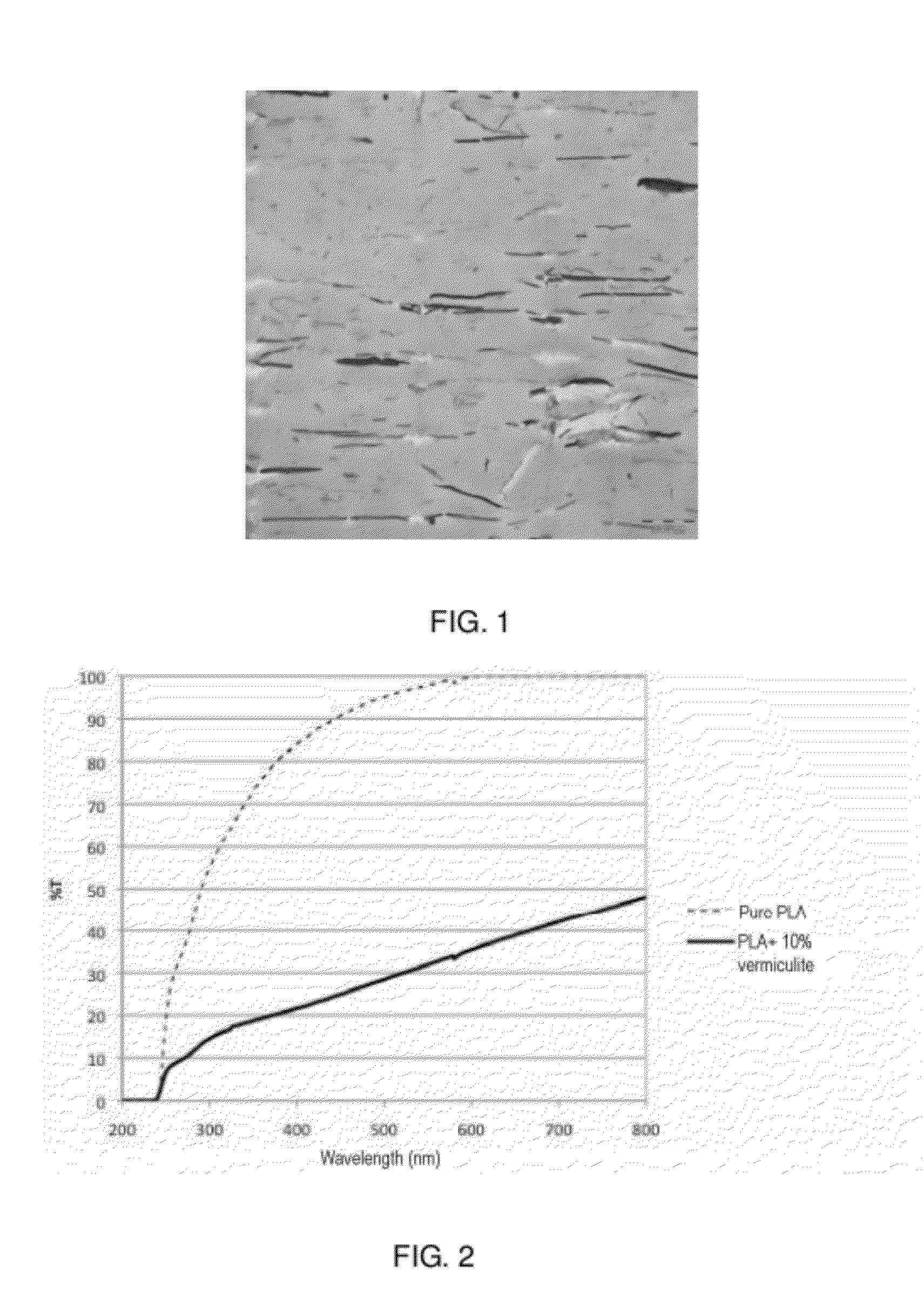Nanocomposite materials having electromagnetic-radiation barrier properties and process for obtainment thereof
a technology of electromagnetic radiation and nanocomposite materials, which is applied in the direction of silicon compounds, lighting and heating apparatuses, instruments, etc., can solve the problems of nanocomposite materials having electromagnetic radiation barrier properties, chemical reactions, and even bleaching, and no specific design has been published describing the manufacturing process of nanocomposite materials for electromagnetic radiation protection applications
- Summary
- Abstract
- Description
- Claims
- Application Information
AI Technical Summary
Benefits of technology
Problems solved by technology
Method used
Image
Examples
example 1
[0055]Polylactic acid films (PLA) with different contents (1%, 5%, 10% and 20%) of clays of the vermiculite type modified with 40% by mass of hexadecyltrimethylammonium bromide and triethylaluminium (AIEt3) as polymerization initiator in 1:1 ratio and of a clay (5%) of montmorillonite type modified with 40% by mass of hexadecyltrimethylammonium bromide and triethylaluminium (AIEt3) in 1:1 ratio. Initially, the modified clay was dispersed in a 0.025 molar solution of lactic acid in tetrahydrofurane (THF) at 70° C. in inert atmosphere. The solvent was eliminated in reduced pressure conditions. The in situ polymerization of the lactic acid was carried out at 120° C. during 48 h after swelling of the clay during 1 h. A film with a 30 micron thickness was formed by melt compression of the resulting nanocomposite. These nanocomposites were characterized studying their morphology by TEM.
example 2
[0056]Another study demonstrated the dispersion capacity of the UV-Vis light. To do this, in the films of around 30 microns, the absorption capacity of UV-Vis radiation was evaluated by means of a UV-Visible spectrophotometer. Whilst the pure polymer has a transmittance of around 100%, the films of PLA +10% clay make it possible to reduce the transmission of UV light between 83-90% thus managing to effectively block the passage of UV radiation and also a large part of visible radiation. In the visible area, it manages to block the radiation up to 65% with an addition of a 10% clay content (see FIG. 2). This type of clays of vermiculite type, suitably modified, produce a strong blocking of the light in both the UV and visible region, due to the great nanometric dispersion reached in the matrix. The application of these biodegradable nanocomposites of polylactic acid give rise to the formation of a packaging material that is very interesting for its use, for example, in the storage of...
PUM
| Property | Measurement | Unit |
|---|---|---|
| particle size | aaaaa | aaaaa |
| particle size | aaaaa | aaaaa |
| particle size | aaaaa | aaaaa |
Abstract
Description
Claims
Application Information
 Login to View More
Login to View More - R&D
- Intellectual Property
- Life Sciences
- Materials
- Tech Scout
- Unparalleled Data Quality
- Higher Quality Content
- 60% Fewer Hallucinations
Browse by: Latest US Patents, China's latest patents, Technical Efficacy Thesaurus, Application Domain, Technology Topic, Popular Technical Reports.
© 2025 PatSnap. All rights reserved.Legal|Privacy policy|Modern Slavery Act Transparency Statement|Sitemap|About US| Contact US: help@patsnap.com

